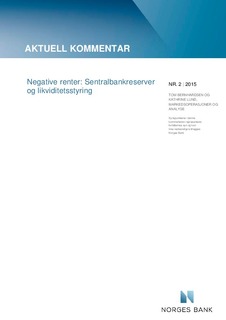| dc.contributor.author | Bernhardsen, Tom | |
| dc.contributor.author | Lund, Kathrine | |
| dc.date.accessioned | 2018-08-15T07:56:00Z | |
| dc.date.available | 2018-08-15T07:56:00Z | |
| dc.date.issued | 2015 | |
| dc.identifier.uri | http://hdl.handle.net/11250/2558042 | |
| dc.description.abstract | In a number of countries, short-term money market rates have now become negative, either because the central bank has set a negative policy rate or because excess central bank reserves are pushing down short-term money market rates towards the rate on the central bank’s marginal deposit facility, which is negative. In Norway, the so-called “reserve rate” is the rate on the central bank’s marginal deposit facility. The reserve rate is intended to give banks an incentive to redistribute reserves among banks. As long as Norges Bank keeps the reserves in the banking system lower than the total of banks’ quotas for sight deposits with Norges Bank, the overnight rate will remain at around the key policy rate. This will also be the case if the reserve rate should become negative. | nb_NO |
| dc.language.iso | eng | nb_NO |
| dc.publisher | Norges Bank | nb_NO |
| dc.relation.ispartofseries | Economic Commentaries;2/2015 | |
| dc.rights | Attribution-NonCommercial-NoDerivatives 4.0 Internasjonal | * |
| dc.rights.uri | http://creativecommons.org/licenses/by-nc-nd/4.0/deed.no | * |
| dc.title | Negative Interest Rates : Central Bank Reserves and Liquidity Management | nb_NO |
| dc.type | Others | nb_NO |
| dc.description.version | publishedVersion | nb_NO |
| dc.subject.nsi | VDP::Samfunnsvitenskap: 200::Økonomi: 210::Samfunnsøkonomi: 212 | nb_NO |
| dc.source.pagenumber | 15 | nb_NO |

